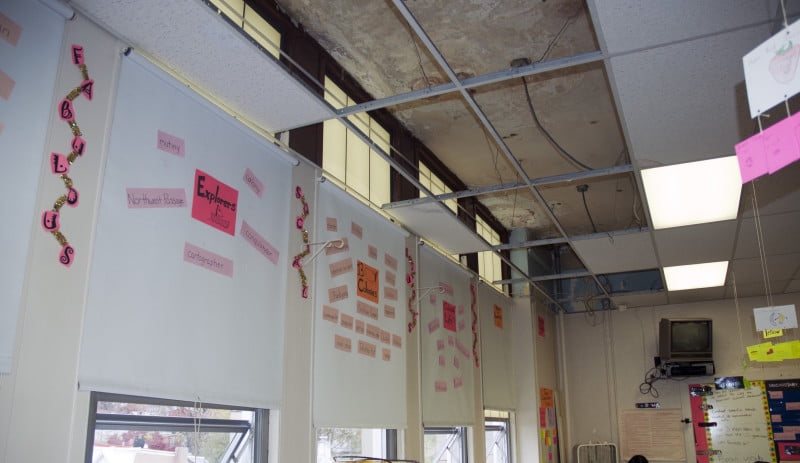
School facilities is second only to highways as the largest sector of public infrastructure spending, but it’s been more than 20 years since the federal government conducted a comprehensive review of the nation’s school buildings. The fill this void, the Center for Green Schools teamed up with 21st Century Fund and theNational Council on School Facilities to comb through any and all relevant data to answer this question: Are we spending enough on school facilities to support student learning?
According to the just-released report, State of Our Schools: America’s K–12 Facilities, the answer is we’re falling short – to the tune of $46 billion. That’s the size of the funding gap needed to bring all U.S. public school facilities up to modern standards.
“The current system of facilities funding leaves school districts unprepared to provide adequate and equitable school facilities… In total, the nation is underspending by $46 billion – an annual shortfall of 32%,” the report states.
The importance of modernizing school infrastructure cannot be overstated. Too many buildings across the country have been allowed to deteriorate as budget cuts have forced districts to forgo maintenance to pay for programs. Millions of educators and students teach and learn surrounded by peeling paint, crumbing plaster, and poor ventilation and faulty heating and cooling systems.
Half of all schools in the United States have problems related to poor indoor air quality, with an astounding 15,000 schools circulating air deemed unfit for students and staff to breathe. State of Our Schools cites the findings of researchers at Lawrence Berkeley Labs, who discovered an increase of 50% to 370 % in respiratory illness in spaces with low ventilation rates, such as schools.
The impact on students is well-established. In addition to the obvious health benefits of fresh air, research also shows that it also helps keep students alert. The report points to several studies that link recirculating air and low ventilation rates in classrooms with lower average daily attendance and slower speed in completing tasks.
“High-quality facilities help improve student achievement, reduce truancy and suspensions, improve staff satisfaction and retention, and raise property values,” the report states. “They also are integral to ensuring equity in educational offerings and opportunities for students.”
“It is totally unacceptable that there are millions of students across the country who are learning in dilapidated, obsolete and unhealthy facilities that pose obstacles to their learning and overall well-being,” says Rick Fedrizzi, CEO and founding chair of USGBC.
The underlying problem, adds Fedrizzi, is that the nation’s public school infrastructure is funded through a system exacerbates inequality. “This has to change, he says.
States’ and public K–12 school districts’ responsibilities for school facilities fall into two main categories: daily maintenance and operations and capital construction. Maintenance funding comes out of annual operating budgets. Money for new construction and other big-ticket projects has to be found in the capital budget. It is here where the inequities proliferate.
While states and the federal government contribute, roughly 45% and 10% respectively, to school districts annual operating costs, the capital investment required to build and modernize buildings falls heavily on local districts and taxpayers. If the wealth in the community isn’t there, new construction usually won’t get funded.

Lower-income districts are often unable to borrow the necessary capital to invest in the long-term stability of their facilities. As a result, they are forced to dip into their operating budgets – money allocated for salaries, equipment, etc. – to afford minor repairs and upgrades. “As such, low-wealth districts often get trapped in a vicious cycle; underspending on routine and preventive maintenance in the short term leads to much higher building costs in the long term,” the report states.
In recent years, a few states have cobbled together new strategies to open up funding avenues, including New Mexico, Iowa, Massachusetts and Ohio. But state-based solutions are generally scarce and even those that have are reasonably successful still don’t reach many of the most-disadvantaged districts.
Ultimately, says Jared Bernstein, senior fellow at the Center on Budget and Policy Priorities and former economic adviser to Vice-President Joe Biden, any real solution requires a federal role, both in terms of greater funding but also expertise. Writing in The Washington Post, Bernstein calls on Congress to reconsider the Fix America’s School Today Act, a one-time federal investment introduced in 2011 to bring the most-neglected schools up to standard. In addition, Bernstein says, “the feds could help with information dissemination regarding best practices for facility upgrades and upkeep. …One could also see a role, perhaps out of the Environmental Protection Agency, for funding health-related upgrades. Or the Energy Department could support the greening of school infrastructures, replacing boilers, windows and roofing, an initiative that also would generate savings against heating and cooling costs.”
Rachel Gutter, Director of the Center for Green Schools at USGBC, agrees that collaboration between stakeholders at all levels of government is key to addressing the problem.
”“The way we fund school infrastructure means that communities and states are working largely on their own to provide high-quality facilities,” Gutter says. “Without new funding models, schools in low-income areas will be unable to meet even the most basic standards for health and safety.”
[Source:- Nea Today]


